While tennis has been a globally renowned sport for centuries, pickleball, a comparably new entrant, has been swiftly scaling the popularity charts. Both sports share similarities – they require agility, precision, and strategy. But each has unique characteristics that shape the gameplay experience significantly.
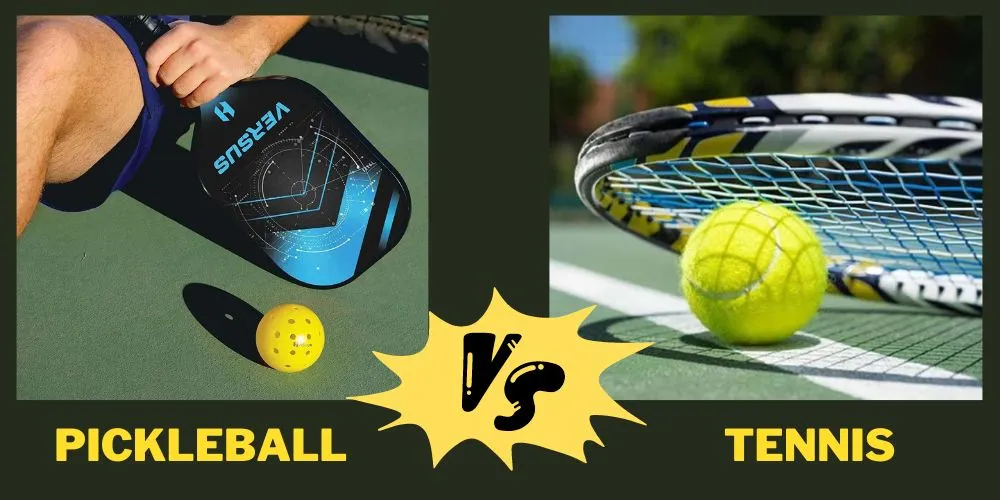
In this article, I delve deep into the world of striking balls with paddles and racquets, exploring the intriguing differences between, and the captivating characteristics of, Pickleball and Tennis.
Pickleball vs Tennis
From the outset, Tennis and Pickleball might appear quite similar, owing to their shared principles of racquet sports. However, upon closer inspection, the unique aspects of each – ranging from their equipment to strategies, fitness benefits and audience – stand out, making them two distinct sports.
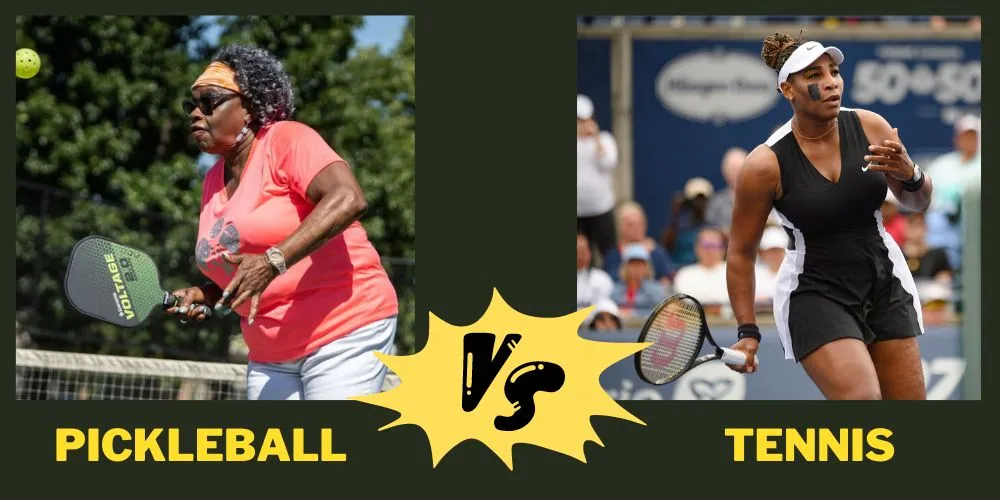
1. Equipment
Tennis
The tennis racket typically measures around 27 inches and features a string bed in an elliptical frame. Its strings, often made from synthetic materials like nylon, are interwoven and tightly strung to strike the ball securely.
Tennis balls are made from rubber and coated with felt to reduce speed. They usually measure 2.57-2.7 inches in diameter and weigh around 2 ounces.
Tennis players generally wear comfortable sports apparel designed for ease of movement. These include tennis shoes, shorts or skorts, and shirts. Accessories might include sweatbands, hats or visor caps, and protective glasses for outdoor games.
Pickleball
Pickleball paddles are smaller than tennis rackets, measuring 15-18 inches. They are usually made from lightweight materials like aluminum, graphite or composite to offer better control.
The pickleball itself is similar to a wiffle ball. It’s lightweight, hollow and drilled with holes. Its design enables it to move slower than a tennis ball, making the game less physically intensive.
Much like tennis, pickleballs players wear sporty and comfortable apparel. However, due to the sport’s less intense nature, a wider range of footwear including trainers, is considered appropriate.
2. Rules and Gameplay
Tennis
Tennis is played on a rectangular court measuring 78 feet by 36 feet. Points are scored by landing the ball in the opponent’s court without it being returned. Serving involves striking the ball diagonally into the opponent’s service box. The detailed rules encompass aspects like fault, double fault, deuce, and advantage.
Pickleball
Pickleball courts are smaller than tennis courts, measuring 44 feet by 20 feet. Scoring in pickleball is done only by the serving team. The serve is performed underhand, and the server can only win points. The unique “double-bounce rule” ensures the ball bounces once on each side before volleys are allowed.
3. Techniques and Strategies
Tennis
Tennis involves various strokes including the serve, forehand, backhand, volley, and smash. Players employ complex strategies, customizing their game based on their opponent’s playing style, game conditions and physical and psychological state.
Pickleball
Pickleball techniques include the serve, forehand and backhand drives, lob, and dink. Strategic plays incorporate positioning, controlling the ‘no volley zone’ or ‘kitchen’, and the judicious use of power and soft game.
4. Health and Fitness Benefits
- Tennis: Tennis is a high-intensity game resulting in improved aerobic fitness, increased burning of calories, better coordination and balance, bone health, and improved muscular strength. It also boosts mental agility, requiring strategic thinking and quick decision-making abilities.
- Pickleball: While not as physically intense as tennis, pickleball does offer several health benefits. It enhances cardio fitness, develops balance and agility, improves reflexes, and boosts mood, without putting too much strain on the body.
5. Popularity and Cultures
- Tennis: Tennis enjoys a fervent following worldwide. It has prestigious tournaments like the four Grand Slams, and fosters a strong community spirit. Its influence permeates pop culture through video games, movies, and fashion.
- Pickleball: While pickleball is less globally recognized than tennis, it’s notably growing in popularity, especially among senior communities for its less physically demanding gameplay. Pickleball tournaments are also becoming more prominent, as is its cultural significance.
Pickleball and Tennis have their unique merits, and choosing between them relies on personal preferences. Whether it be the vigorous match-play of tennis, or the strategic allegro pacing of pickleball, these games exemplify the spirit of sporting joy.
Pickleball vs Tennis: Which is Better?
To determine whether pickleball or tennis is the “better” sport falls greatly to individual preference influenced by factors such as physical fitness, interest in competitiveness, and desire for social interaction. Both sports have considerable merits in their respective arenas.
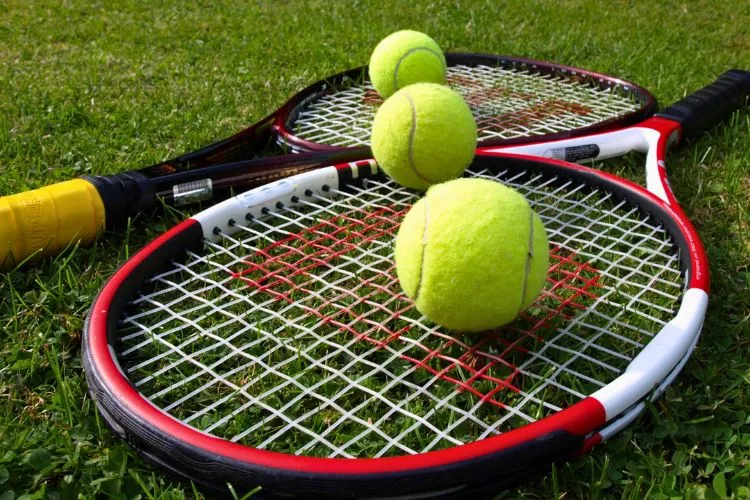
Health and Fitness
If high-intensity workouts drive you, tennis might be the preferable choice. The court is larger, the ball moves faster, and the games are often longer, which means a higher degree of physical exertion, leading to improved aerobic fitness, more calories burned, and improved bone and muscle health.
On the other hand, pickleball provides a moderately intense workout, putting less strain on the body. This can be beneficial, especially for seniors or those returning to sports after an injury. The smaller court size and slower ball speed offer more controlled physical activity while offering good cardio fitness.
Skills and Learning Curve
Tennis has a steeper learning curve requiring mastery of a diverse range of strokes like forehand, backhand, smash, and volley and an understanding of complex rules. This might be more appealing to those who enjoy the challenge of developing a wide array of skills and techniques.
On the other hand, pickleball offers a simpler set of rules, making it easier for beginners to pick up the game quickly. With fewer stroke types to learn, it can be more accessible for individuals of all ages and physical abilities.
Social and Competitive Aspects
Tennis is highly competitive and widely recognized, with major tournaments held worldwide. If global prestige, intense rivalry, and the opportunity to climb the ranks motivates you, tennis might be the better option.
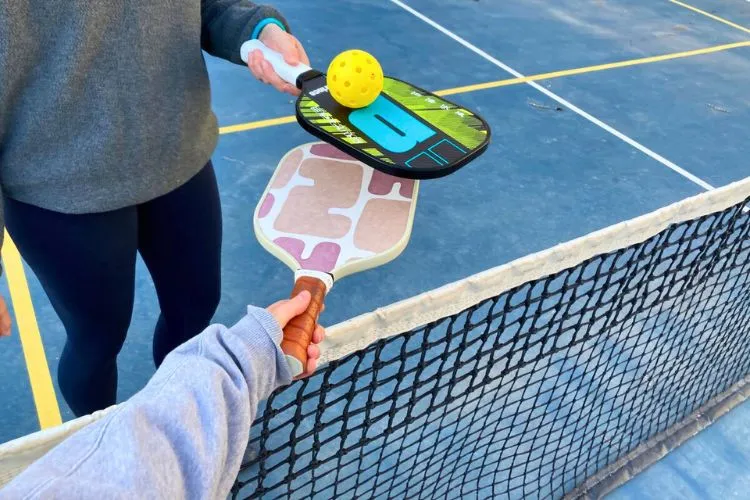
Pickleball has a strong social and community aspect. The slower pace of the game encourages more social interaction between points. Additionally, the growing popularity of pickleball is seeing an increase in competitive tournaments – although on a smaller scale compared to tennis.
Whether pickleball or tennis is “better” depends on your likes, physical ability, and what you seek to gain from the sport. For intense competition and a strenuous workout, tennis is a perfect choice. Pickleball is a great option if you’re looking for a more relaxed, social game that keeps you active. It’s recommended to try both and see which one resonates more with you.
Is pickleball easier on joints than tennis?
Yes, pickleball is generally considered easier on the joints compared to tennis due to several factors:
- Smaller court size: Since pickleball is played on a smaller court (44 feet by 20 feet) compared to a tennis court (78 feet by 36 feet), there is less running and fewer abrupt stops, putting less stress on the joints, particularly the knee and ankle joints.
- Slower ball speed: The unique design of the pickleball, with its hollow structure and drilled holes, results in a slower ball speed. With less energy imparted to the ball, players don’t have to hit or react as forcefully, resulting in reduced impact on the joints, especially in the shoulder, elbow, and wrist.
- Underhand serve: Unlike tennis, where serves are usually overhead and powerful, pickleball serves are performed underhand with a more fluid motion. This style of serving puts less strain on the shoulder, elbow, and wrist joints, reducing the risk of injuries commonly associated with tennis such as tennis elbow and rotator cuff problems.
- Less jumping and aggressive movements: Tennis often involves jumping and explosive movements, which put more pressure on the joints. In contrast, pickleball requires fewer high-intensity movements, allowing for a more controlled and less impactful playing experience.
Why do people like pickleball more than tennis?
Several reasons contribute to pickleball’s growing popularity and preference over tennis for some individuals:
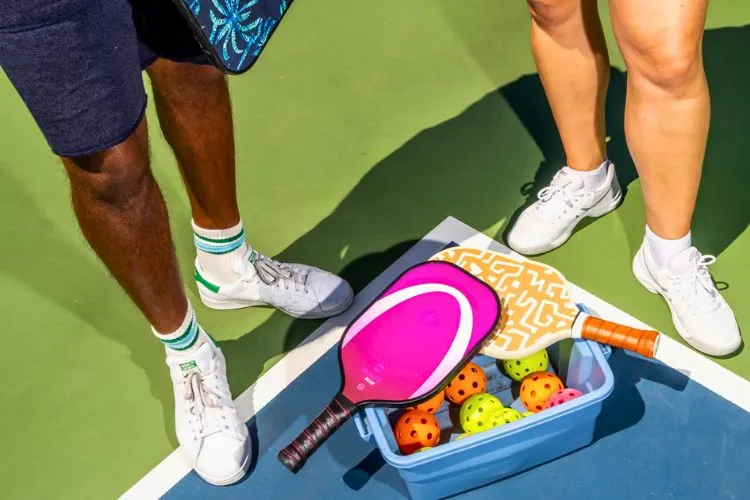
- Easier learning curve: Pickleball has simpler rules, basic techniques, and minimal specialized strokes. This makes it easier for beginners to pick up and enjoy the game compared to the more complex and nuanced techniques in tennis.
- Social and community aspect: The nature of pickleball allows players to socialize and interact more during games. The slower-paced game creates a relaxed environment that fosters camaraderie and interaction among players across different age groups and skill levels.
- Lower physical impact: As discussed earlier, pickleball is less taxing on the joints and requires less physical exertion than tennis. This makes it a more attractive choice for individuals with joint pain, seniors, or those not looking for an intense workout but still want to engage in an enjoyable physical activity.
- Inclusivity: The slower pace and shorter court make pickleball more accessible to a wider range of ages and abilities, including children, seniors, and people with varying levels of mobility. This inclusivity makes the sport appealing to a broader audience seeking an engaging and fun experience.
- Shorter games: Pickleball games are shorter than tennis matches, making it easier to fit into a busy schedule or enjoy a quick game during breaks. The relatively shorter duration also enhances its appeal as a recreational activity.
The Growing Popularity and Future of Pickleball
Pickleball, once a niche sport primarily enjoyed by older adults, has seen a meteoric rise in popularity, particularly in North America.
According to the Sports & Fitness Industry Association (SFIA), pickleball is one of the fastest-growing sports in the U.S., with participation increasing by double digits in recent years. The sport’s appeal is partly due to its accessibility, as it can be played by people of all ages and skill levels.
The relatively low-impact nature of the game makes it especially popular among older adults who may have previously played tennis or other racquet sports but found them too physically demanding.
Many tennis courts are being repurposed to accommodate pickleball, as the sport thrives in community centers, local gyms, and recreational facilities.
Pickleball’s growth has led to the creation of dedicated courts, and cities across the country are investing in building pickleball-specific infrastructure.
The growth of the sport has also spurred the rise of competitive leagues, professional tournaments, and even pickleball influencers on social media, further propelling its reach.
In terms of demographics, pickleball is attracting a diverse group of players, from families with young children to retirees seeking a more relaxed but still competitive sport.
This broad appeal has led to increased community engagement and the creation of pickleball clubs that offer both recreational and competitive play.
Moreover, the sport’s simple setup and rules make it an ideal option for schools and youth programs, further ensuring its growth and sustainability.
Looking ahead, the future of pickleball appears bright. As more people discover the benefits of the sport, it is likely to continue its expansion, potentially challenging more established sports like tennis in terms of participation and infrastructure.
With its accessibility, social benefits, and relatively low barrier to entry, pickleball is on track to become a fixture in the world of recreational and competitive sports.
Conclusion:
Both pickleball and tennis have distinct appeals. Tennis, with its globally followed tournaments, provides intensive workout opportunities and a sophisticated range of techniques.
On the other hand, pickleball is a more accessible and social sport, with fewer demands on physicality and joint health.
The choice between the two largely depends on individual preferences for competitiveness, physical fitness obligations, and social interaction.
Ultimately, both sports provide excellent avenues for active leisure, physical fitness, and social bonding, enhancing the quality of life and promoting a positive approach towards health and camaraderie. Hope my guide regarding pickleball vs tennis comparison improved your understanding.

Pickleball’s more than a game to me—it’s a passion. I write, sharing its highs and lows, the thrills and the lessons. Some tales might draw you to the court, while others give a hint of the game’s magic. So, curious about my journey? Ready to dive deep into the world of pickleball with me? Let’s go.
